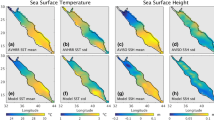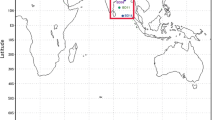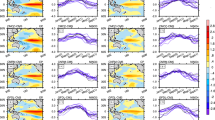Abstract
In this study, we assess systematically the impact of different initialisation procedures on the predictability of the sea ice in the Southern Ocean. These initialisation strategies are based on three data assimilation methods: the nudging, the particle filter with sequential importance resampling and the nudging proposal particle filter. An Earth system model of intermediate complexity is used to perform hindcast simulations in a perfect model approach. The predictability of the Antarctic sea ice at interannual to multi-decadal timescales is estimated through two aspects: the spread of the hindcast ensemble, indicating the uncertainty of the ensemble, and the correlation between the ensemble mean and the pseudo-observations, used to assess the accuracy of the prediction. Our results show that at decadal timescales more sophisticated data assimilation methods as well as denser pseudo-observations used to initialise the hindcasts decrease the spread of the ensemble. However, our experiments did not clearly demonstrate that one of the initialisation methods systematically provides with a more accurate prediction of the sea ice in the Southern Ocean than the others. Overall, the predictability at interannual timescales is limited to 3 years ahead at most. At multi-decadal timescales, the trends in sea ice extent computed over the time period just after the initialisation are clearly better correlated between the hindcasts and the pseudo-observations if the initialisation takes into account the pseudo-observations. The correlation reaches values larger than 0.5 in winter. This high correlation has likely its origin in the slow evolution of the ocean ensured by its strong thermal inertia, showing the importance of the quality of the initialisation below the sea ice.










Similar content being viewed by others

References
Bintanja R, van Oldenborgh GJ, Drijfhout SS, Wouters B, Katsman CA (2013) Important role for ocean warming and increased ice-shelf melt in Antarctic sea-ice expansion. Nat Geosci 6(5):376–379
Bitz CM, Polvani LM (2012) Antarctic climate response to stratospheric ozone depletion in a fine resolution ocean climate model. Geophys Res Lett 39(20). doi:10.1029/2012GL053393
Bitz CM, Gent PR, Woodgate RA, Holland MM, Lindsay R (2006) The influence of sea ice on ocean heat uptake in response to increasing CO2. J Clim 19(11):2437–2450
Blanchard-Wrigglesworth E, Bitz CM, Holland MM (2011) Influence of initial conditions and climate forcing on predicting Arctic sea ice. Geophys Res Lett 38(18)
Brohan P, Kennedy JJ, Harris I, Tett SFB, Jones PD (2006) Uncertainty estimates in regional and global observed temperature changes: a new data set from 1850. J Geophys Res 111(D12). doi:10.1029/2005JD006548
Brovkin V, Bendtsen J, Claussen M, Ganopolski A, Kubatzki C, Petoukhov V, Andreev A (2002) Carbon cycle, vegetation, and climate dynamics in the Holocene: experiments with the CLIMBER-2 model. Global Biogeochem Cycles 16(4):1139. doi:10.1029/2001GB001662
Comiso J (1999) Bootstrap sea ice concentrations from Nimbus-7 SMMR and DMSP SSM/I-SSMIS. Version 2, January 1980 to December 2009, Boulder, Colorado USA: NASA DAAC at the National Snow and Ice Data Center
Comiso JC, Nishio F (2008) Trends in the sea ice cover using enhanced and compatible AMSR-E, SSM/I, and SMMR data. J Geophys Res 113(C02S07). doi:10.1029/2007JC004257
Day JJ, Tietsche S, Hawkins E (2014) Pan-arctic and regional sea ice predictability: initialization month dependence. J Clim 27(12):4371–4390. doi:10.1175/JCLI-D-13-00614.1
Döscher R, Wyser K, Meier HEM, Qian M, Redler R (2010) Quantifying Arctic contributions to climate predictability in a regional coupled ocean–ice–atmosphere model. Clim Dynam 34(7–8):1157–1176. doi:10.1007/s00382-009-0567-y
Dubinkina S, Goosse H (2013) An assessment of particle filtering methods and nudging for climate state reconstructions. Clim Past 9(3):1141–1152. doi:10.5194/cp-9-1141-2013
Dubinkina S, Goosse H, Sallaz-Damaz Y, Crespin E, Crucifix M (2011) Testing a particle filter to reconstruct climate changes over the past centuries. Int J Bifurc Chaos 21(12):3611–3618. doi:10.1142/S0218127411030763
Dunstone NJ, Smith DM (2010) Impact of atmosphere and sub-surface ocean data on decadal climate prediction. Geophys Res Lett 37(2): doi:10.1029/2009GL041609
Fetterer F, Knowles K, Meier W, Savoie M (2002) Sea Ice Index, January 1980 to December 2009, Boulder, Colorado USA: National Snow and Ice Data Center. doi:10.7265/N5QJ7F7W
Germe A, Chevallier M, Salas y Mélia D, Sanchez-Gomez E, Cassou C (2014) Interannual predictability of Arctic sea ice in a global climate model: regional contrasts and temporal evolution. Clim Dynam 1–20. doi:10.1007/s00382-014-2071-2
Goddard L et al (2012) A verification framework for interannual-to-decadal predictions experiments. Clim Dynam. doi:10.1007/s00382-012-1481-2
Goosse H, Fichefet T (1999) Importance of ice–ocean interactions for the global ocean circulation: a model study. J Geophys Res Oceans 104(C10):23337–23355
Goosse H, Zunz V (2014) Decadal trends in the Antarctic sea ice extent ultimately controlled by ice–ocean feedback. Cryosphere 8(2):453–470. doi:10.5194/tc-8-453-2014
Goosse H, Lefebvre W, de Montety A, Crespin E, Orsi A (2009) Consistent past half-century trends in the atmosphere, the sea ice and the ocean at high southern latitudes, Clim Dynam 33(7):999–1016-1016
Goosse H et al (2010) Description of the earth system model of intermediate complexity LOVECLIM version 1.2, geoscientific model. Development 3(2):603–633. doi:10.5194/gmd-3-603-2010
Holland MM, Blanchard-Wrigglesworth E, Kay J, Vavrus S (2013) Initial-value predictability of Antarctic sea ice in the community climate system Model 3. Geophys Res Lett 40(10):2121–2124. doi:10.1002/grl.50410
Holland PR, Kwok R (2012) Wind-driven trends in Antarctic sea-ice drift. Nat Geosci 5(12):872–875
Kalnay E (2007) Atmospheric modeling, data assimilation and predictability, 4th edn. Cambridge University Press, Cambridge
Keenlyside N, Latif M, Jungclaus JH, Kornbueh L, Roeckner E (2008) Advancing decadal-scale climate prediction in the North Atlantic sector. Nature 453:84–88. doi:10.1038/nature06921
Kim H-M, Webster PJ, Curry JA (2012) Evaluation of short-term climate change prediction in multi-model CMIP5 decadal hindcasts. Geophys Res Lett 39(10). doi:10.1029/2012GL051644
Kirkman CH, Bitz CM (2010) The effect of the sea ice freshwater flux on southern ocean temperatures in CCSM3: deep-ocean warming and delayed surface warming. J Clim 24(9):2224–2237
Koenigk T, Mikolajewicz U (2009) Seasonal to interannual climate predictability in mid and high northern latitudes in a global coupled model. Clim Dynam 32(6):783–798
Kröger J, Müller W, von Storch J-S (2012) Impact of different ocean reanalyses on decadal climate prediction. Clim Dynam 39(3):795–810
Landrum L, Holland MM, Schneider DP, Hunke E (2012) Antarctic sea ice climatology, variability, and late twentieth-century change in CCSM4. J Clim 25(14):4817–4838
Lefebvre W, Goosse H (2008) An analysis of the atmospheric processes driving the large-scale winter sea ice variability in the Southern Ocean. J Geophys Res 113(C2). doi:10.1029/2006JC004032
Mahlstein I, Gent PR, Solomon S (2013) Historical Antarctic mean sea ice area, sea ice trends, and winds in CMIP5 simulations. J Geophys Res Atmos 118:1–6. doi:10.1002/jgrd.50443
Martinson DG, Killworth PD, Gordon AL (1981) A convective model for the Weddell Polynya. J Phys Oceanogr 11(4):466–488
Matei D, Pohlmann H, Jungclaus J, Müller W, Haak H, Marotzke J (2012a) Two tales of initializing decadal climate prediction experiments with the ECHAM5/MPI-OM model. J Clim 25(24):8502–8523
Matei D, Baehr J, Jungclaus JH, Haak H, Müller WA, Marotzke J (2012b) Multiyear prediction of monthly mean Atlantic meridional overturning circulation at \(26.5^{\circ }\text{ N }\). Science 335(6064):76–79
Msadek R, Dixon KW, Delworth TL, Hurlin W (2010) Assessing the predictability of the Atlantic meridional overturning circulation and associated fingerprints. Geophys Res Lett 37(19). doi:10.1029/2010GL044517
Murphy J, Kattsov V, Keenlyside N, Kimoto M, Meehl G, Mehta V, Pohlmann H, Scaife A, Smith D (2010) Towards prediction of decadal climate variability and change. Procedia Environ Sci 1:287–304
Notz D (2014) Sea-ice extent and its trend provide limited metrics of model performance. Cryosphere 8(1):229–243. doi:10.5194/tc-8-229-2014
Opsteegh JD, Haarsma R, Selten F, Kattenberg A (1998) ECBILT: a dynamic alternative to mixed boundary conditions in ocean models. Tellus A 50(3):348–367
Parkinson CL, Cavalieri DJ (2012) Antarctic sea ice variability and trends, 1979–2010. Cryosphere 6(4):871–880
Phelps MW, Kumar A, O’Brien JJ (2004) Potential predictability in the NCEP CPC dynamical seasonal forecast system. J Clim 17(19):3775–3785
Pierce DW, Barnett TP, Tokmakian R, Semtner A, Maltrud M, Lysne J, Craig A (2004) The ACPI project, element 1: initializing a coupled climate model from observed conditions. Clim Change 62(1):13–28
Pohlmann H, Botzet M, Latif M, Roesch A, Wild M, Tschuck P (2004) Estimating the decadal predictability of a coupled AOGCM. J Clim 17(22):4463–4472. doi:10.1175/3209.1
Pohlmann H, Jungclaus JH, Köhl A, Stammer D, Marotzke J (2009) Initializing decadal climate predictions with the GECCO oceanic synthesis: effects on the North Atlantic. J Clim 22(14):3926–3938
Pohlmann H, Smith D, Balmaseda M, Keenlyside N, Masina S, Matei D, Müller W, Rogel P (2013) Predictability of the mid-latitude Atlantic meridional overturning circulation in a multi-model system. Clim Dynam 41(3–4):775–785
Polvani LM, Smith KL (2013) Can natural variability explain observed Antarctic sea ice trends? New modeling evidence from CMIP5. Geophys Res Lett 40(12):3195–3199
Servonnat J, Mignot J, Guilyardi E, Swingedouw D, Séférian R, Labetoulle S (2014) Reconstructing the subsurface ocean decadal variability using surface nudging in a perfect model framework. Clim Dynam 1–24. doi:10.1007/s00382-014-2184-7
Sigmond M, Fyfe JC (2010) Has the ozone hole contributed to increased Antarctic sea ice extent? Geophys Res Lett 37(18). doi:10.1029/2010GL044301
Simpkins GR, Ciasto LM, England MH (2013) Observed variations in multidecadal Antarctic sea ice trends during 1979–2012. Geophys Res Lett 3643–3648. doi:10.1002/grl.50715
Smith D, Eade R, Pohlmann H (2013) A comparison of full-field and anomaly initialization for seasonal to decadal climate prediction. Clim Dynam 41(11–12):3325–3338
Smith DM, Eade R, Dunstone NJ, Fereday D, Murphy JM, Pohlmann H, Scaife AA (2010) Skilful multi-year predictions of Atlantic hurricane frequency. Nat Geosci 3(12):846–849. doi:10.1038/NGEO1004
Smith KL, Polvani LM, Marsh DR (2012) Mitigation of 21st century Antarctic sea ice loss by stratospheric ozone recovery. Geophys Res Lett 39(20). doi:10.1029/2012GL053325
Solomon S (1999) Stratospheric ozone depletion: a review of concepts and history. Rev Geophys 37(3):275–316
Stammerjohn SE, Martinson DG, Smith RC, Yuan X, Rind D (2008) Trends in Antarctic annual sea ice retreat and advance and their relation to El Niño Southern Oscillation and Southern Annular Mode variability. J Geophys Res 113(C3). doi:10.1029/2007JC004269
Swingedouw D, Mignot J, Labetoulle S, Guilyardi E, Madec G (2012) Initialisation and predictability of the AMOC over the last 50 years in a climate model. Clim Dynam 40(9–10):2381–2399. doi:10.1007/s00382-012-1516-8
Talagrand O (1997) Assimilation of observations, an introduction. J Meteorol Soc Jpn Ser II 75(1B):191–209
Taylor KE, Stouffer RJ, Meehl GA (2011) An overview of CMIP5 and the experiment design. Bull Am Meteorol Soc 93(4):485–498
Tietsche S, Notz D, Jungclaus J, Marotzke J (2013) Predictability of large interannual Arctic sea–ice anomalies. Clim Dynam 41(9–10):2511–2526
Turner J, Bracegirdle TJ, Phillips T, Marshall GJ, Hosking JS (2013) An initial assessment of Antarctic sea ice extent in the CMIP5 models. J Clim 26(5):1473–1484. doi:10.1175/JCLI-D-12-00068.1
van Leeuwen PJ (2009) Particle filtering in geophysical systems. Month Weather Rev 137(12):4089–4114. doi:10.1175/2009MWR2835.1
van Leeuwen PJ (2010) Nonlinear data assimilation in geosciences: an extremely efficient particle filter. Q J R Meteorol Soc 136(653):1991–1999
Zhang J (2007) Increasing Antarctic sea ice under warming atmospheric and oceanic conditions. J Clim 20(11):2515–2529
Zunz V, Goosse H, Massonnet F (2013) How does internal variability influence the ability of CMIP5 models to reproduce the recent trend in Southern Ocean sea ice extent? Cryosphere 7(2):451–468. doi:10.5194/tc-7-451-2013
Acknowledgments
V. Zunz is Research Fellow with the Fonds pour la formation la Recherche dans l’Industrie et dans l’Agronomie (FRIA-Belgium). H. Goosse is Senior Research Associate with the Fonds National de la Recherche Scientifique (F.R.S. – FNRS-Belgium). This work is supported by the Belgian Federal Science Policy (Research Program on Science for a Sustainable Development). Computational resources have been provided by the supercomputing facilities of the Université catholique de Louvain (CISM/UCL) and the Consortium des Equipements de Calcul Intensif en Fédération Wallonie Bruxelles (CECI) funded by the Fond de la Recherche Scientifique de Belgique (FRS-FNRS). We thank three anonymous referees for their careful reading and constructive comments.
Author information
Authors and Affiliations
Corresponding author
Rights and permissions
About this article
Cite this article
Zunz, V., Goosse, H. & Dubinkina, S. Impact of the initialisation on the predictability of the Southern Ocean sea ice at interannual to multi-decadal timescales. Clim Dyn 44, 2267–2286 (2015). https://doi.org/10.1007/s00382-014-2344-9
Received:
Accepted:
Published:
Issue Date:
DOI: https://doi.org/10.1007/s00382-014-2344-9



